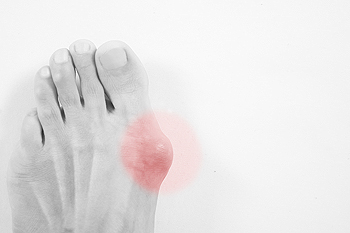Can Bunions Develop as a Result of Having Arthritis?
Monday, 04 November 2019 00:00 A large bump on the side of the big toe may indicate that a bunion has developed. It is considered to be a deformity, and calluses may form on the top as a result of friction against shoes that are worn. Additionally, blisters may appear, and it may become painful, red, and swollen. Common causes why bunions can develop can consist of genetic factors, and wearing shoes that do not have adequate room for the toes to move freely in. Research has indicated that patients who are afflicted with arthritis may notice a bunion forming over painful joints in the big toe. There may be methods that can be implemented which may help to prevent bunions from developing. These can include wearing shoes that have a lower heel, and avoiding backless shoes. If you have a bunion, it is suggested that you seek the advice of a podiatrist who can offer you correct methods of treatment.
A large bump on the side of the big toe may indicate that a bunion has developed. It is considered to be a deformity, and calluses may form on the top as a result of friction against shoes that are worn. Additionally, blisters may appear, and it may become painful, red, and swollen. Common causes why bunions can develop can consist of genetic factors, and wearing shoes that do not have adequate room for the toes to move freely in. Research has indicated that patients who are afflicted with arthritis may notice a bunion forming over painful joints in the big toe. There may be methods that can be implemented which may help to prevent bunions from developing. These can include wearing shoes that have a lower heel, and avoiding backless shoes. If you have a bunion, it is suggested that you seek the advice of a podiatrist who can offer you correct methods of treatment.
If you are suffering from bunions, contact Dr. Michael A. Wood of Foot Health Institute. Our doctor can provide the care you need to keep you pain-free and on your feet.
What Is a Bunion?
A bunion is formed of swollen tissue or an enlargement of boney growth, usually located at the base joint of the toe that connects to the foot. The swelling occurs due to the bones in the big toe shifting inward, which impacts the other toes of the foot. This causes the area around the base of the big toe to become inflamed and painful.
Why Do Bunions Form?
Genetics – Susceptibility to bunions are often hereditary
Stress on the feet – Poorly fitted and uncomfortable footwear that places stress on feet, such as heels, can worsen existing bunions
How Are Bunions Diagnosed?
Doctors often perform two tests – blood tests and x-rays – when trying to diagnose bunions, especially in the early stages of development. Blood tests help determine if the foot pain is being caused by something else, such as arthritis, while x-rays provide a clear picture of your bone structure to your doctor.
How Are Bunions Treated?
- Refrain from wearing heels or similar shoes that cause discomfort
- Select wider shoes that can provide more comfort and reduce pain
- Anti-inflammatory and pain management drugs
- Orthotics or foot inserts
- Surgery
If you have any questions, please feel free to contact one of our offices located in Lansing, and Chicago, IL . We offer the newest diagnostic and treatment technologies for all your foot care needs.




